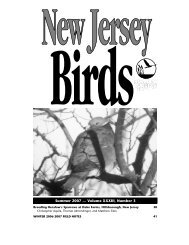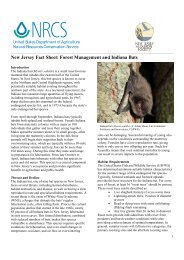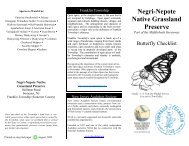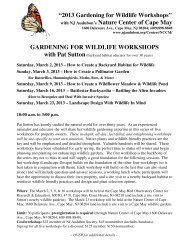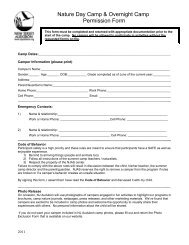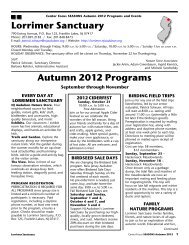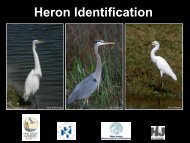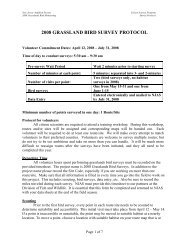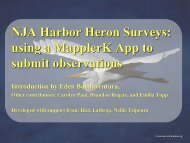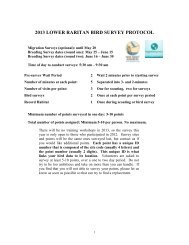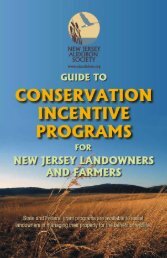Birding for Boaters - New Jersey Audubon Society
Birding for Boaters - New Jersey Audubon Society
Birding for Boaters - New Jersey Audubon Society
Create successful ePaper yourself
Turn your PDF publications into a flip-book with our unique Google optimized e-Paper software.
<strong>Birding</strong><strong>for</strong> <strong>Boaters</strong>Common Birds of<strong>New</strong> <strong>Jersey</strong>’s Coastal WatersThe <strong>New</strong> <strong>Jersey</strong> <strong>Audubon</strong> <strong>Society</strong>(NJAS) fosters environmental awarenessand a conservation ethic among<strong>New</strong> <strong>Jersey</strong>’s citizens; protects <strong>New</strong><strong>Jersey</strong> birds, mammals, other animalsand plants, especially endangered andthreatened species and promotespreservation of <strong>New</strong> <strong>Jersey</strong>’s valuablenatural habitats. To become a memberof NJAS or to learn more about theorganization, call 908-204-8998 or visitwww.njaudubon.orgFunding <strong>for</strong> this publication was providedby the <strong>New</strong> <strong>Jersey</strong> Department ofTransportation, Office of MaritimeResources, I BOAT NJ ProgramThe I BOAT NJ Program provides grantfunds to selected eligible applicants topromote, improve and enhance the marine industry inthe State of <strong>New</strong> <strong>Jersey</strong> <strong>for</strong> the benefit of the generalboating public.www.state.nj.us/transportation/works/maritime/marine_trades_IBOAT.shtmFor more in<strong>for</strong>mation about where togo and what to do in <strong>New</strong> <strong>Jersey</strong>, go towww.state.nj.us/travel or call1800VISITNJ.<strong>New</strong> <strong>Jersey</strong> enjoys a wide varietyof distinct habitats from highland mountains, topineland <strong>for</strong>ests, to sandy beaches, to scenicrivers and windswept bayshore marshlands. Infact, due to its coastal location on the Atlanticflyway, its relatively small size and undeniableabundance of wildlife, it is <strong>New</strong> <strong>Jersey</strong> thatboasts the highest density of wildlife persquare mile of any state in the nation! <strong>New</strong><strong>Jersey</strong>, the fourth smallest state, hosts over340 bird species, 90 mammal species, 79 reptileand amphibian species and over 400 fishspecies in its 8,722 square miles.<strong>New</strong> <strong>Jersey</strong>’s ocean coastline extends approximately125 miles from Sandy Hook in the northto Cape May in the south. Additionally, about150 square miles of wetland habitats are affectedby tidal waters associated with Raritan and<strong>New</strong>ark Bays, <strong>New</strong> York Harbor and theDelaware Estuary. Specific birds are associatedwith these wetland habitats. Some of thesebirds are residents— living in the state all yearround, but the vast majority are migrant speciesthat either pass through our state on their wayto other places or they come here to nest.This introductory brochure identifies 28common coastal bird species you might seewhile enjoying a day on your boat. Several ofthese have been designated “threatened” or“endangered” which af<strong>for</strong>ds them extraprotection beyond what is already given to allmigratory birds. These are by no means theonly birds you will see along our coastline. For amore complete list of <strong>New</strong> <strong>Jersey</strong> birds and/ora recommendation <strong>for</strong> a bird identificationguide, contact your local <strong>New</strong> <strong>Jersey</strong> <strong>Audubon</strong>center — www.njaudubon.org.Safe boating andhappy birding!
Open WaterAmerican Black Duck – this blackbodied,tan-headed duck, about thesize of a Mallard is common duringthe cooler months and nests alongour coast. Look <strong>for</strong> white underwingflashes when it flies.Double-crested Cormorant –long aerial lines of these black birdscan be seen during migration; individualsare found along the coastyear-round. At close range notethe orange facial skin and boldlycoloredeyes. They often standerect with outstretched wings.Osprey (Threatened) – this “fishhawk” catches its food by plungingfeet first into the water. They canbe identified in flight by their w-shaped wing pattern and black andwhite heads. Ospreys will nest onmanmade plat<strong>for</strong>ms as well as cellphone towers, channel markers and buildings.WetlandsClapper Rail – a secretive chickenlikebird of the salt marsh which isusually heard more than seen.Listen <strong>for</strong> their resonant “kek-kekkek”call that speeds up. Best timeto see them is at low tide whenthey venture onto mudflats.Glossy Ibis – an exotic-lookingwading bird with an iridescentbronze, black, and green body andlong, sickle-shaped bill. Duringspring and summer, colonies ofGlossy Ibis are found in several locationsof the Intracoastal Waterway.Black-crowned Night-Heron(Threatened) – mostly nocturnal,these birds become active arounddusk and can often be heard makinga loud “quawk” call. Note thebird’s black back and cap, thickneck and shorter-legged stancethan other herons and egrets.Great Blue Heron – a familiar“crane-like” bird of the marsh.Their distinctive profile includeslong legs, an s-curved neck, shaggybreast feathers, and bluish-grayfeathers. They eat a wide variety ofanimals including fish, frogs,rodents, and small birds.Great Egret – a white bird with ayellow beak, similar in size andshape to the Great Blue Heron.They feed by standing statue-likeand then striking prey quickly.Once hunted <strong>for</strong> its exquisitebreeding plumes, this species hasmade a remarkable comeback.Snowy Egret – much smaller thanthe Great Egret, this species iswhite with a black bill, and blacklegs with bright golden-yellow feet.Snowy Egrets are active feeders,shuffling their “golden slippers”through shallow water to stir upthe bottom and expose prey.Marsh Wren – a loud, bubblingsong often reveals the presenceof this small, brownish bird.They are found in a variety ofwell-vegetated wetlands, oftenperching on reeds, with tails inthe air.Red-winged Blackbird – with ablack body and bold red shoulders,the male of this species is an obviousresident of coastal habitats.Females are more camouflaged,with streaked brown plumage.Males make a distinctive “konk-aree”sound.Tree Swallow – a small, glossy,blue-backed bird that eats mostlyinsects. During early fall, hugeflocks gather along barrier islandsand coastal marshes be<strong>for</strong>e migratingsouth <strong>for</strong> the winter. Duringmigration, if insects are scarce,they will also eat bayberries.Beaches/MudflatsAmerican Oystercatcher – a longand flattened orange bill, blackhead and back, white underparts,and flesh-colored legs identify thislarge shorebird. Nesting on undisturbedbeaches and marshes, oystercatchersbreak through clamshells with a chisel-pointed bill.Willet – easy to identify in flightwith a bold black-and-white wingpattern, this species vigorously andloudly defends its nesting territoryfrom all intruders, saying “I’m-a-Willet. I’m-a-Willet!” Willets feed ona variety of worms and crustaceansalong beaches and wetlands.
Sanderling – the classic gray andwhite sandpiper often seen playing“chicken” with waves along ourbeaches, this Arctic-nesting shorebirdcan be seen along the coastfrom July to May.Piping Plover (Endangered) – thisbeach nester is a sparrow-sizedshorebird that arrives in March anddeparts in September. Foundalmost exclusively on ocean sidebeaches and sand flats, this bird’scamouflaged coloration makes itdifficult to see.Laughing Gull – abundant alongthe coast, this smallish gull is afamiliar sight anywhere along the<strong>Jersey</strong> shore from March toNovember. Its distinctive“ha’ha’ha” call gives the bird itsname. The largest nesting colonyin the world is near Stone Harbor.Herring Gull – a common yearroundresident of the shore, thisspecies takes four years to reachmaturity and shows a variety ofplumages. Young birds are mostlybrown, slowly changing to thewhite-headed and gray-backedadult over time.Great Black-backed Gull – thelargest gull in the world, thisspecies’ populations increasedgreatly in NJ. Young birds arecheckered brown and white whileadults are black-backed and whitebodied with a powerful yellow bill.Least Tern (Endangered) – this littletern nests locally from SandyHook to Cape May. It can be separatedfrom other terns by its smallsize and yellow bill.Common Tern – smaller and moregraceful than gulls, this speciesnests on coastal islands and protectedbeaches. They hunt <strong>for</strong>small fish by hovering over thewater, then diving. Note the pointywings, <strong>for</strong>ked tail, and black capthat help distinguish it from gulls.Use the check boxes torecord your bird sightings!Royal Tern – this species is largerthan Common Tern and has asmall black crest and orange bill.After nesting in the mid-Atlanticthis species spends late summerand fall along the <strong>Jersey</strong> shore.They feed on small fish by aerialdives.Black Skimmer (Endangered) –best known <strong>for</strong> its feeding style.Flying just above the surface, theycut the water with their elongated,knife-like lower bill. This speciesnests on undisturbed beaches andremote islands in our coastalwaterways. Listen <strong>for</strong> their barking call while the birds<strong>for</strong>age around sunrise and sunset.MarinasBarn Swallow – often nestingaround old buildings and docks,these small, insect-eating birdshave a <strong>for</strong>ked tail, orange underparts,and a blue back.Belted Kingfisher – easily recognizableby its blue upperparts, longbill, and shaggy crest, this birdperches conspicuously near waterand hover-hunts <strong>for</strong> small fish.Boat-tailed Grackle – found onlyalong the coast, this large memberof the blackbird family nests in saltmarshes and eats small fish andcrustaceans. During winter they<strong>for</strong>m large flocks and may befound in residential areas, marinas,and cities.Fish Crow – almost identical toAmerican Crow, these birds canbe distinguished by their nasal“uh-oh” call and coastal distribution.Fish Crows are commonscavengers along <strong>New</strong> <strong>Jersey</strong>’scoastline.Turkey Vulture – with a featherlessred head, huge silvery wings,and v-shaped flight silhouette, thisscavenger is a common sight anywherealong the <strong>Jersey</strong> Shore.They locate food using a keensense of smell.
Bird-friendly Boating Practices• Minimize boat and personal watercraft wakes,especially in shallow water areas. Boat wakescan cause shoreline erosion, increase turbidity,and damage important sea grasses thatprovide nesting and <strong>for</strong>aging sites <strong>for</strong> avariety of estuary species.• Take advantage of pump-out facilities—do notdischarge wastewater holding tanks into ourwaterways. Obtain a free guide showing locationsof all <strong>New</strong> <strong>Jersey</strong>’s pumpout stations bycontacting NJ Division of Fish and Wildlife’sClean Vessel Act Office at 609-748-2056 or atwww.njfishandwildlife.com/cvadir.htm• Keep trash in secure containers and disposeof it on land. Floatable trash can be mistakenby fish, turtles, and birds as food. Ingestingsuch items may cause death.• Dispose of monofilament fishing line, hooksand lures in a proper manner. Birds and otheranimals may get tangled in the line.• Maintain your boat engine to minimize oilleaks. Use a bilge pillow or other oil absorbentmaterials to reduce oil being pumped intowaterways along with bilge water.• Avoid approaching nest colonies of plovers,terns, and skimmers. Usually these are ropedoff to prevent human disturbance. When birdsleave the nest <strong>for</strong> any length of time fledglingsmay die of exposure to heat/cold or bevulnerable to predation by gulls and crows.NOTE: The NJ Department of EnvironmentalProtection maintains a current animal rehabilitationlist. In the event you find an injured bird oranimal, this list can be accessed at the NJ DEPwebsite—www.state.nj.us/dep/fgw/rehablst.htm.Tips on How to Identify a BirdIn order to identify a bird, one must be willingto watch it. Binoculars help, but are notnecessary. Most birdwatchers use the followingguidelines to help identify a bird they don’tknow.Size. Determine if the bird is bigger or smallerthan other species — especially ones youalready know. Is it the size of a gull, a crow, asparrow, a robin?Shape. Does the bird have an overallstreamlined shape and structure or is it roundand dumpy? Is it long-legged, long-necked orjust the opposite? These are questions you canpose and answer as you look at an unknownbird.Behavior. What is the bird doing? Is it walkingslowly or running along the beach? How doesthe bird feed? Each bird species has its ownbody language and this can be used to helpidentify it — even from a distance.Habitat. The type of habitat in which you seethe bird can often help narrow down thecandidates. Note that the brochure associatesparticular birds with particular habitats.Although these are suggested, birds movearound and there is often overlap in habitat use.Coloration. Look at overall color or colorcombinations to help identify bird species.Does the bird have a particular striking patternto its wings? Does it show speckling or stripingor some other kind of distinctive featherfeatures?Sound. Most birds have specific call notes theyuse to communicate with each other or tosound the alarm <strong>for</strong> predators and/ordisturbance. One can learn to identify a birdspecies just by the call.



